- latex 图
- latex 图
- latex表
- LateX (1)
- c# latex - C# (1)
- c# latex - C# 代码示例
- html中的latex(1)
- LateX - 任何代码示例
- 如何使用Latex(1)
- 如何使用Latex
- 安装LaTeX
- 安装LaTeX(1)
- 什么是LaTeX(1)
- 什么是LaTeX
- html代码示例中的latex
- 新命令 - latex - C# (1)
- latex 图像
- latex 矩阵(1)
- latex 矩阵
- latex 颜色(1)
- latex 颜色
- 新命令 - latex - C# 代码示例
- LaTeX教程
- LaTeX教程(1)
- latex格式(1)
- latex格式
- LaTeX 中的字体
- LaTeX 中的字体(1)
- LaTeX中的字体(1)
📅 最后修改于: 2021-01-06 00:35:19 🧑 作者: Mango
乳胶清单
Latex列表用于添加任何其他软件包。有三种类型的列表。一个是枚举列表,它产生编号列表。第二个是itemize ,用于项目符号列表。第三个是描述列表,既没有项目符号,也没有编号。在Latex中,每个列表由\ item定义。通过这种方法,也可以创建子列表。
列表的示例如下所示:
\begin{enumerate}
\item first point
\item second point
\begin{itemize}
\item first sub-point
\item second sub-point
\end{itemize}
\item third point
\end{enumerate}
下图显示了它的输出:
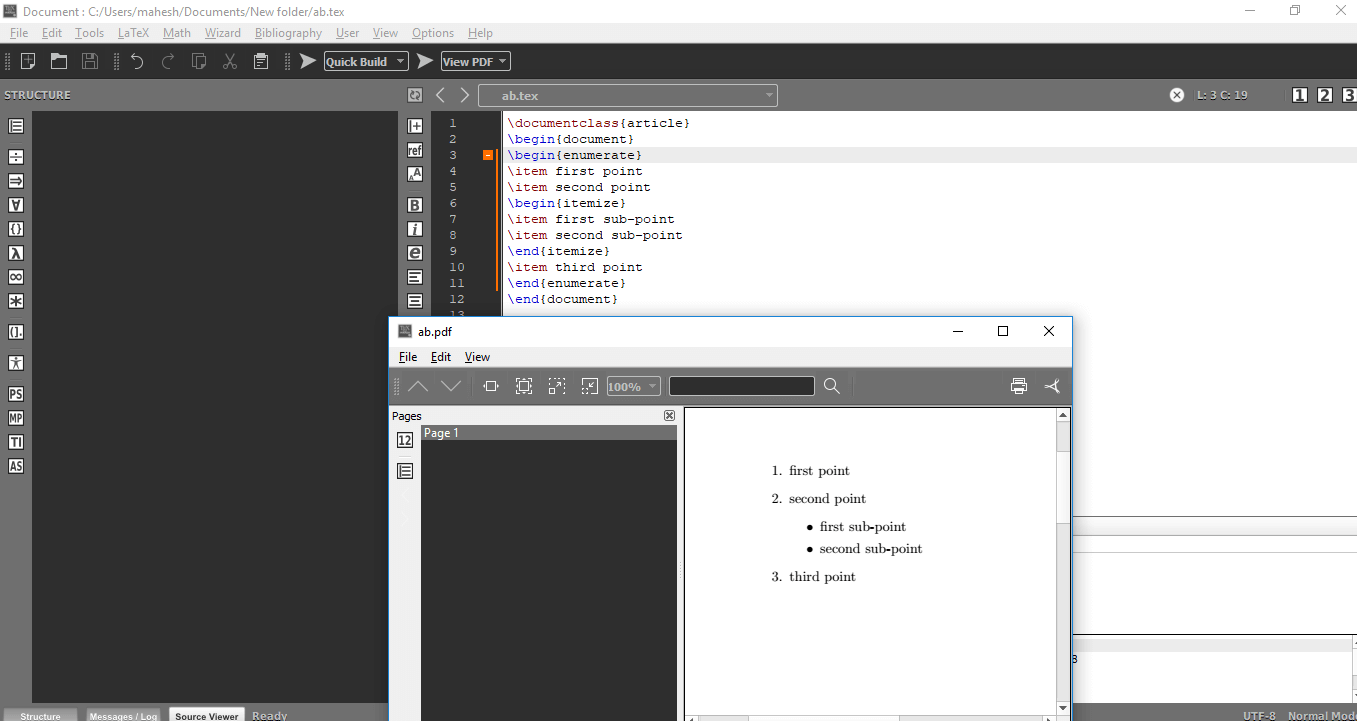
1.列举
它用于创建编号列表。
下面给出了枚举列表的简单代码:
\documentclass{article}
\begin{document}
\begin{enumerate}
\item this is the first point
\item this is the second point
\end{enumerate}
\end{document}
输出如下图所示:
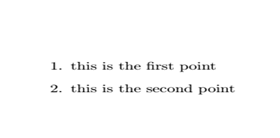
2.逐项
它用于创建未编号的列表。示例如下:
\documentclass{article}
\begin{document}
\begin{itemize}
\item this is the first point
\item this is the second point
\end{itemize}
\end{document}
输出如下图所示:
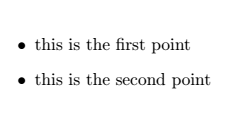
3.说明
描述列表是鲜为人知的。当您需要解释术语或符号时使用。下面给出了“描述”列表的程序或代码:
\documentclass{article}
\begin{document}
\begin{description}
\item[Chemistry] the study of behavior of elements and compounds
\item[History] the study of past
\item[Geology] the study of the solid Earth
\end{description}
\end{document}
输出如下图所示:

嵌套列表
对于上述所有列表,嵌套列表用于创建不同的环境。这也意味着可以为列表的项目创建一个子列表。级别数的最大深度为四。嵌套列表的示例如下:
\documentclass[12pt]{article}
\begin{document}
\begin{enumerate}
\item One
\begin{enumerate}
\item First
\item Second
\item Third
\end{enumerate}
\item Two
\item Three
\end{enumerate}
\end{document}
输出如下图所示:
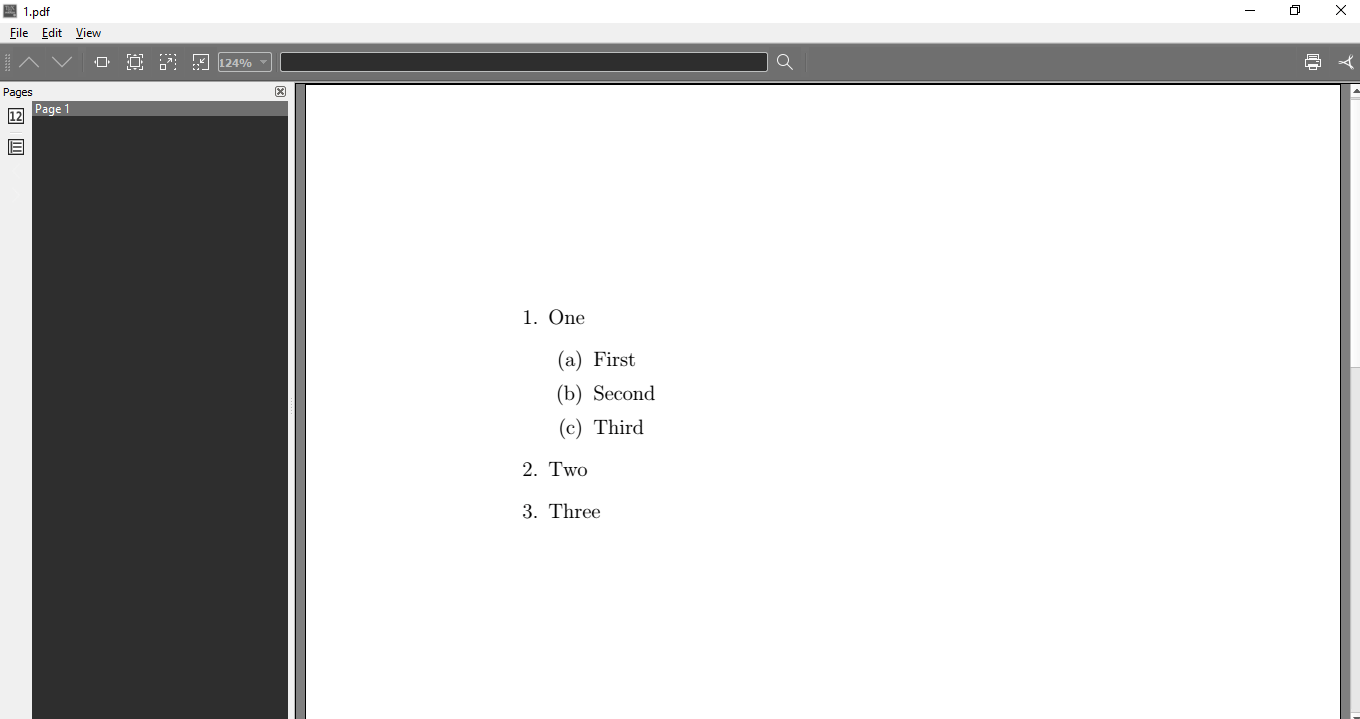
嵌套列表的编号样式取决于列表的深度。让我们考虑另一个示例:
\documentclass[17pt]{article}
\begin{document}
\begin{enumerate}
\item first is entered
\item another item of first
\begin{enumerate}
\item Second one
\item another item of second
\begin{enumerate}
\item third is entered
\item another item of third
\begin{enumerate}
\item Fourth one
\item another item of fourth
\end{enumerate}
\end{enumerate}
\end{enumerate}
\end{enumerate}
\end{document}
在Texmaker中编写上述代码后,屏幕将如下图所示:
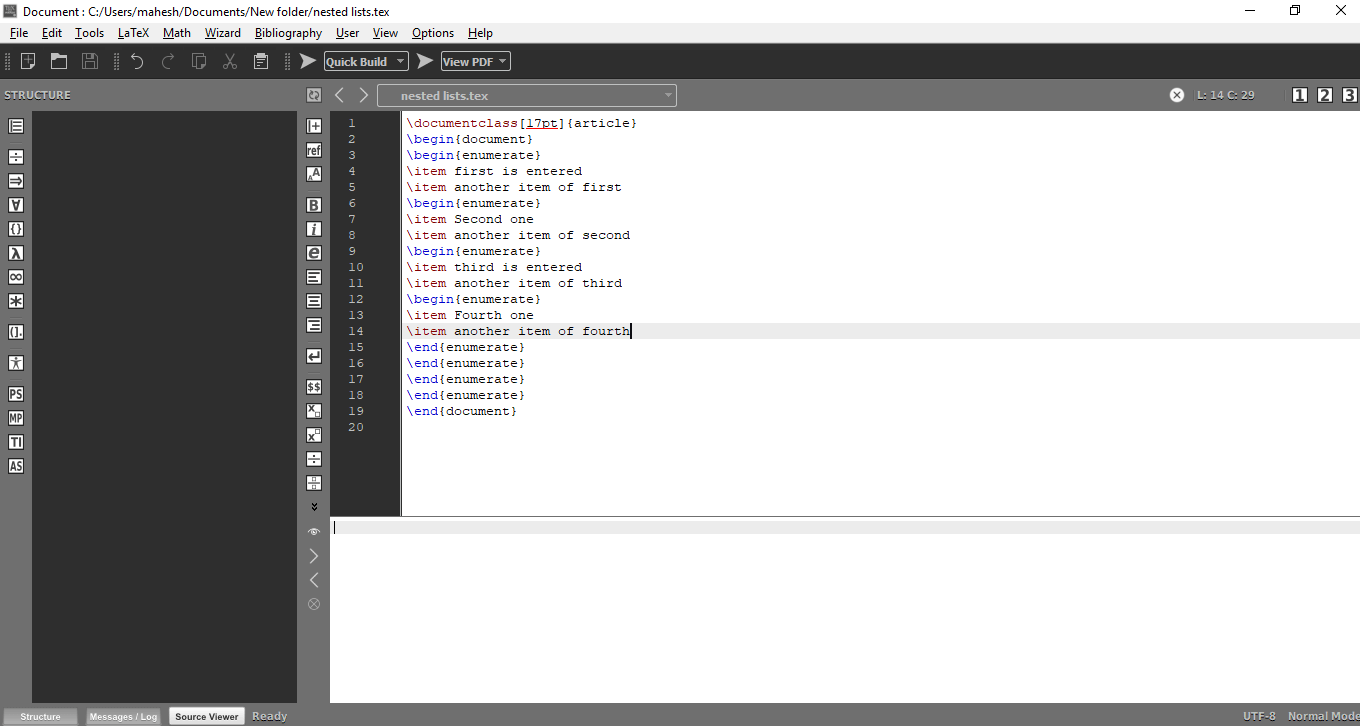
如前所述,保存文件,然后单击“快速构建”选项以编译程序。输出如下图所示:
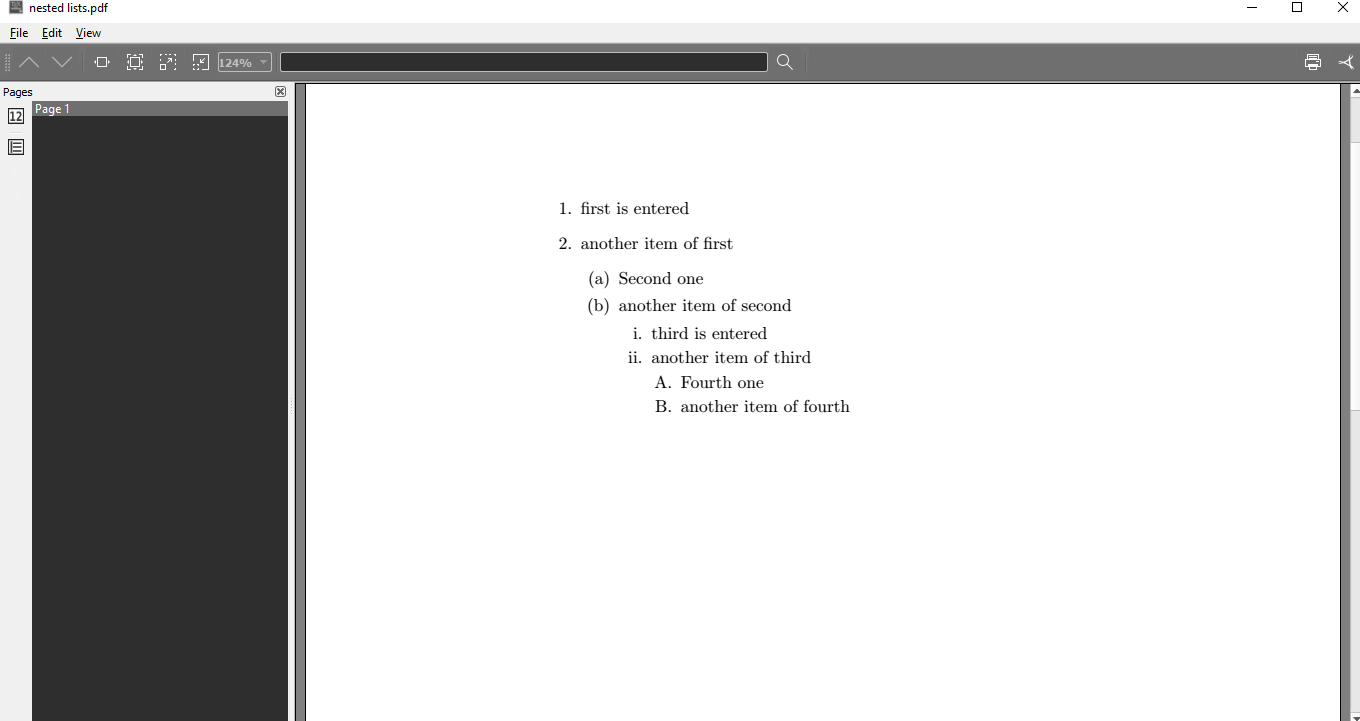
您会注意到,这取决于列表的深度。编号列表会相应调整。
注意:\ itemsep命令用于控制项目之间的间距。它仅在命令开始之后使用。
乳胶列表也根据顺序进行分类,即有序列表和无序列表。这两个列表的示例如下:
1.有序列表
Latex为有序列表提供枚举环境。让我们考虑一个例子。此处编写的代码在Texmaker中用于生成输出。下面给出了有序列表的示例:
\documentclass[12pt]{article}
\begin{document}
\begin{enumerate}
\item First
\item Second
\item Third
\end{enumerate}
\end{document}
输出如下图所示:
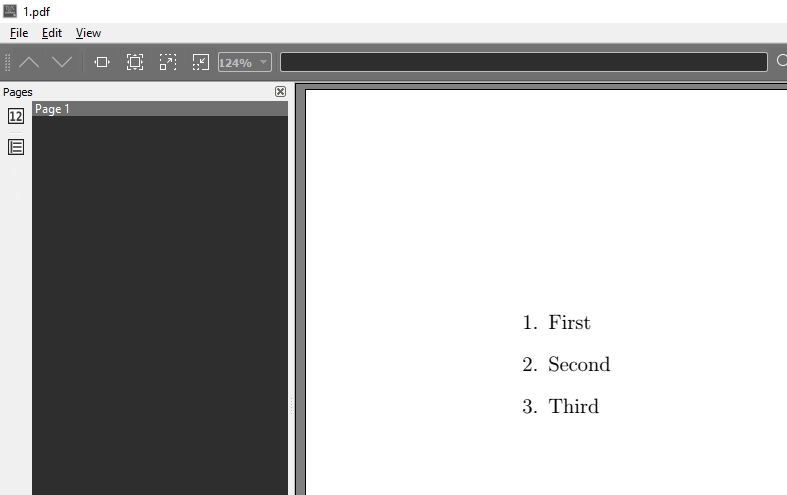
2.无序列表
对于无序列表,Latex提供了逐项列出环境。它也无需任何其他程序包即可工作。在下面给出的示例中,代码与有序列表的代码相同,只是使用枚举代替了枚举。
\documentclass[12pt]{article}
\begin{document}
\begin{itemize}
\item First
\item Second
\item Third
\end{itemize}
\end{document}
输出如下图所示:

对于这两种环境,Latex提供了\ item命令,该命令必须在开始时声明。
更改乳胶列表的项目符号和编号模式/格式
有时,有必要更改项目符号和列表编号以使用其他格式。众所周知,对于特殊字符的输入,在开头和结尾使用$符号。下面列出了有序列表和无序列表的方法:
- 无序列表
如果将格式从项目符号更改为破折号,则使用以下命令:
\item[--] or \item[$-$]
如果将格式从项目符号更改为星号,则使用以下命令:
\item[$\ast$]
如果将格式从项目符号更改为特定字符,则使用以下命令:
\item[$ \Any character$]
更换子弹的程序如下:
\documentclass[14pt]{article}
\begin{document}
\begin{itemize}
\item[--] Dash
\item[$-$] Dash
\item[$\ast$] Asterisk
\item[$\#$] hash character used
\end{itemize}
\end{document}
Texmaker中上述代码的输出如下:

- 有序列表
如果要更改环境,这是一个棘手的过程。最简单的步骤是使用enumitem环境。与usepackage {enumitem}之类的usepackage命令一起使用。
下面列出了以下列表的代码:
\documentclass[12pt]{article}
\usepackage{enumitem}
\begin{document}
\begin{enumerate}[label=(\alph*)]
\item one item
\item two item
\begin{enumerate}[label=(\arabic*)]
\item third item
\item fourth item
\begin{enumerate}[label=(\roman*)]
\item fifth item
\item sixth item
\end{enumerate}
\end{enumerate}
\end{enumerate}
\end{document}
编写完上述程序后,Texmaker屏幕将如下图所示:

输出如下:

您还可以对无序列表使用enumitem选项更改列表中所有项目的符号。
- 逐项
在这种类型的列表中,renew命令用于在不同级别更改项目符号的大小。让我们通过一个例子来理解这一点。这些命令可用于替换项目符号的格式。示例如下:
\documentclass{article}
\begin{document}
\renewcommand{\labelitemi}{$\ast$}
\renewcommand{\labelitemii}{$\cdot$}
\renewcommand{\labelitemiii}{$\diamond$}
\begin{itemize}
\item this is the first point
\begin{itemize}
\item this is the second point
\begin{itemize}
\item this is the third point
\end{itemize}
\end{itemize}
\end{itemize}
\end{document}
输出如下图所示:
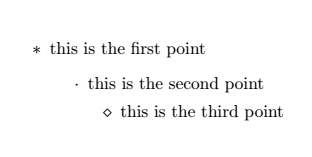
在不同级别上使用的标签命令是:
- 1级的labelitemi
- 2级的labelitemii
- 3级的labelitemiii
- 4级的labelitemiv
- 编号列表样式
下面列出了可用于编号列表的样式:
| Code | Description |
|---|---|
| \Alph | Used for the uppercase (A, B, C…) |
| \alph | Used for the lowercase (a, b, c, d….) |
| \roman | For the lowercase roman numerals (i, ii, iii, iv…) |
| \Roman | For the uppercase roman numerals (I, II, III, IV…) |
| \arabic | Used for the Arabic numbers (1, 2, 3, 4, 5…) |
要更改起始编号或起始编号,可以将\ setcounter用于枚举类型列表。下例显示了此类型的代码:
\documentclass{article}
\begin{document}
\renewcommand{\labelitemiii}{\Roman{enumiii}}
\begin{enumerate}
\item first item
\item first number item
\begin{enumerate}
\item second item
\item second number item
\begin{enumerate}
\setcounter{enumiii}{6}
\item third item
\item third number item
\end{enumerate}
\end{enumerate}
\end{enumerate}
\end{document}
编写完上面的代码后,Texmaker屏幕将如下图所示:
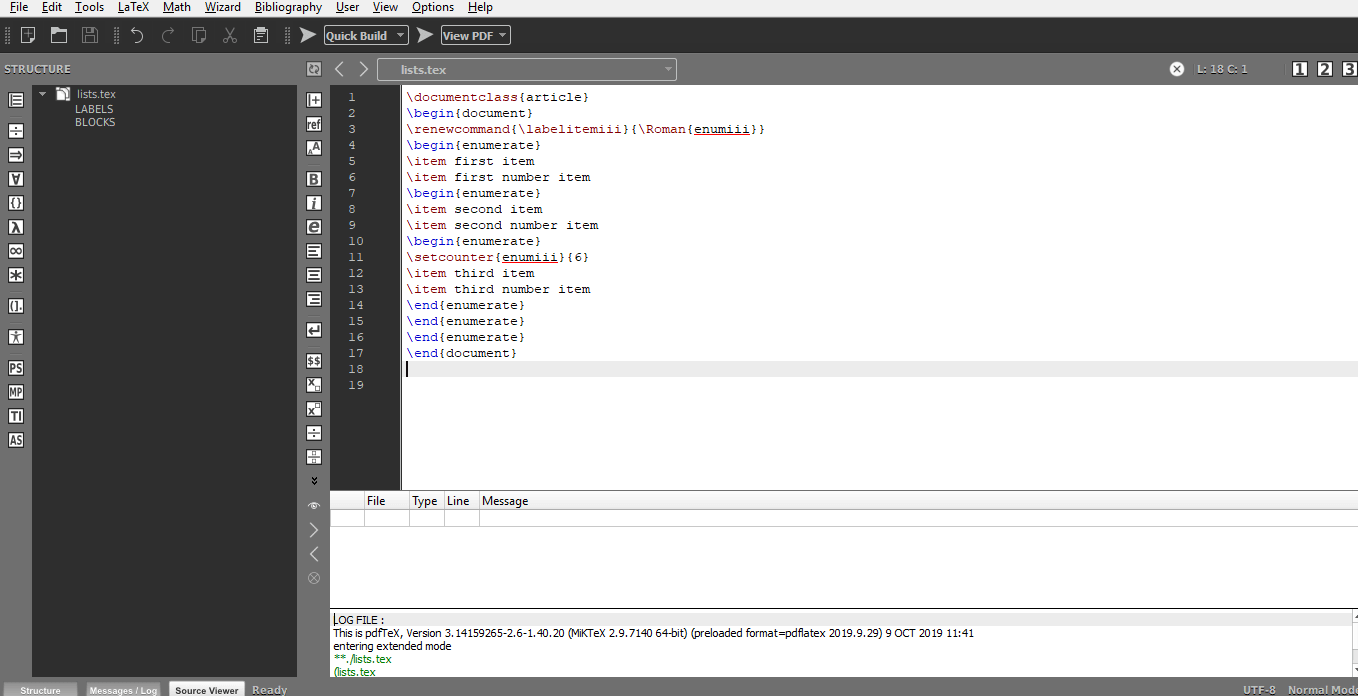
输出如下图所示:

间距参数
这些命令用于更改列表的间距参数。根据文档样式和选项的不同,此处常用的null {}命令将选择默认间距。
下面提到可以在此处使用的spaces命令:
- \ itemsep:用于项目之间的额外垂直空间
- \ rightmargin:右边距与环境列表之间的水平距离
- \ leftmargin:左边距与环境列表之间的水平距离
- \ topsep:列表顶部的多余垂直空间
- \ labelsep:项目的第一行与包含标签的框的末尾之间的分隔。
- \ labelwidth:包含标签的框的常规宽度
- \ parsep:项目中各段落之间的垂直空格。
- \ makelabel {label}:用于生成标签,由\ item命令打印